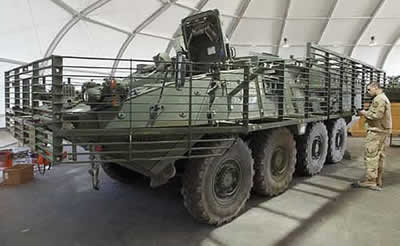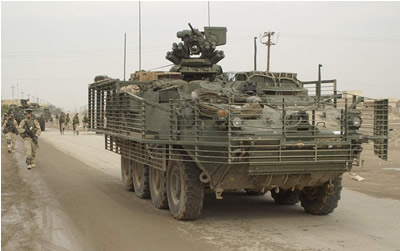The interim slat armor solution forms a metal frame barrier 50 cm ahead of the APC. The cage detonate anti-tank shaped charge warheads such as RPG away from the vehicle and prevent its hot chemical reaction from boring through and causing burns, shock and shrapnel wounds. General Dynamics, the Stryker manufacturer, is also developing an add-on plate armor that will defeat RPGs, planned for deployment by 2005. The slat armor weighs about 5,200 pounds, about 3,000 pounds lighter than the add-on anti-RPG add-on armor plates. The idea behind the cage armor goes back to World War II and Vietnam. Troops in that war improvised with chicken wire and other means to counter the RPG threat.
In Iraq, Slat armor proved quite successful in defeating attacks of High Explosive Anti-Tank (HEAT) of Rocket Propelled Grenade (RPGs). This type of armor is not effective Attacks by high explosive and fragmentation RPG rounds which explode before they hit the cage. In one mission, a Stryker vehicle, with slat armor, was attacked and hit with nine RPGs. The locations of the hits on the vehicle were sporadic. The crew escaped with minor injuries and the vehicle moved under its own power to the nearest operating base for assessment and repair. To improving protection for exposed crews, some units have built a wooden platform over the ramp to hold sand bags to protect the rear hatch. ammunition cans filled with sand were located around the gunners hatch.
While Slat armor does not significantly impact Stryker handling, off or on roads, during the dry season, the additional weight significantly impacts the handling and performance during the rainy season. The additional weight of the slat armor was not accounted for in the design of the Central Tire Inflation System (CTIS). The heavy oversized cage causes multiple problems for safe and effective operation of the vehicle.
Slat armor was initially deployed with US Army Stryker AFVs operating in Iraq. The British Army deployed similar protection to augment the armor of the Warrior AIFV. Similar modifications were performed on Australian Light Armored Vehicles.























